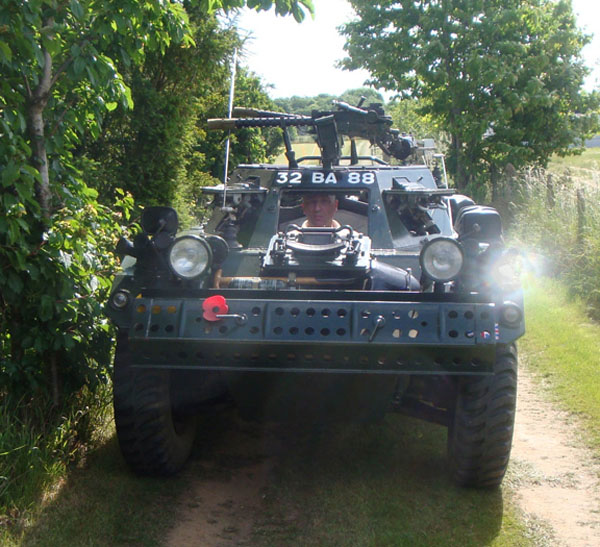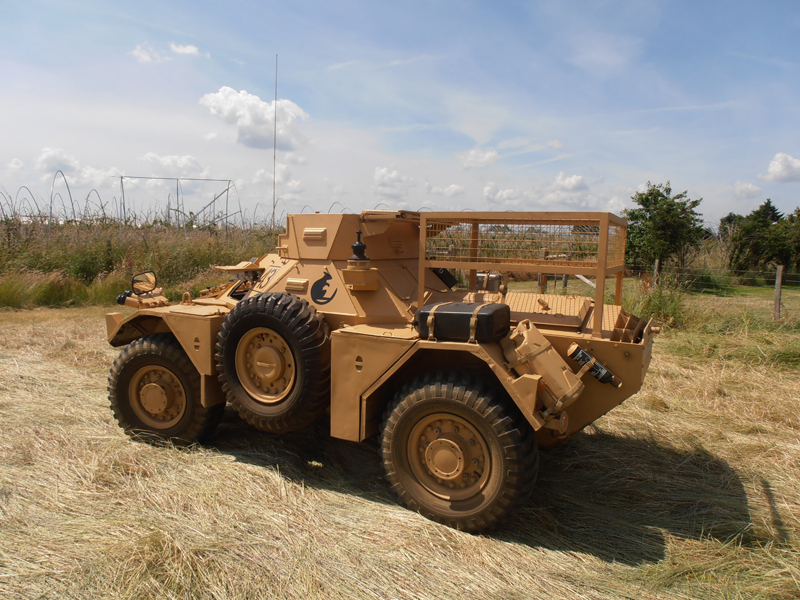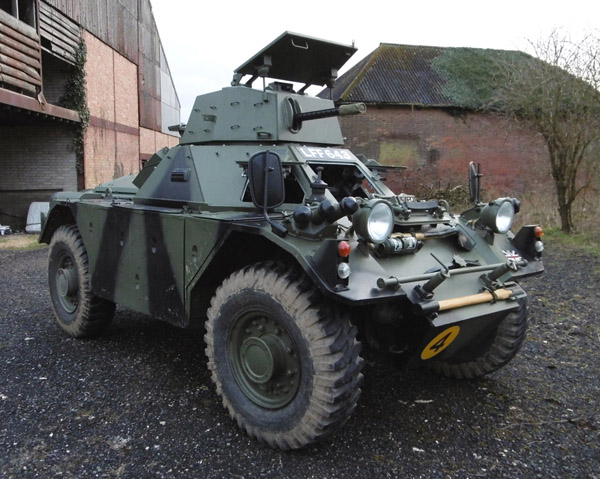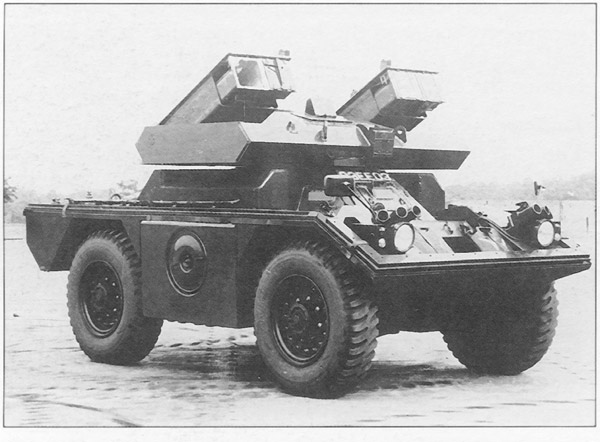Ferret Mk 1
This is called Car Scout 4×4 Liaison (Ferret Mk 1) FV701(C) and has an open top which can be covered by a canvas. It is armed with a 0.303 Bren LMG or a 0.30 Browning machine gun on a pintle mount, with 450 rounds of machine gun ammunition carried.
- Ferret Mk 1/1, FV701(J) A later up-armoured production model. Both Mk1 and Mk 1/1 versions with the suffix M are fitted with a fire-fighting system. A canvas cover was provided to protect the vehicle from the elements.
- Ferret Mk 1/2 (FV704) Identical to the Mk 1 but has a crew of three and was used by infantry units as a light reconnaissance vehicle in forward areas. Its official designation is Car Scout Liaison (Ferret) Mk 1/2. It has an armoured roof with a hatch and is armed with a 7.62 mm pintle-mounted L4A4 Bren LMG (pintle-mounted weapons were phased out, and are now rare, due to the lack of crew protection). The single-piece hatch cover opens to the rear and periscopes and vision blocks are provided for observation by the commander.
The Ferret Mk 1/3 FV701(J) was a standard Mk 1/1 fitted with a rubberised-fabric flotation screen as a development vehicle only (see also Mk 3, below).
Ferret Mk 2
This is basically a Mk 1 fitted with a turret and is officially known as the Car Scout 4×4, Reconnaissance (Ferret) Mk 2 FV701(E) and was fitted with a 30-cal Browning machine gun. The Mk 2/1 FV701(F) was a Mk 2 fitted with a larger two-door rotating turret with additional stowage for a 0.303 Bren gun. The Ferret Mk 2/2 FV701(G) was a local modification to a Mk 2/1 vehicle carried out in Malaysia having an extension collar fitted between the top of the hull and the Browning machine gun turret which enables the commander/gunner to have a better field of fire.
- Ferret Mk 2/3 (FV701H)
This is a later production up-armoured model of the basic Mk 2 and is officially known as the Scout Car Reconnaissance Mk 2/3 (Daimler Ferret 4×4) FV701(H). Most vehicles were fitted with VHF radio, and those additionally fitted with fire-fighting equipment in the crew compartment carried the suffix M. The Ferret Mk 2/4 had additonal retro-fitted appliqué armoured plates fitted to the turret and rear of the hull. The Ferret Mk 2/5 is a Ferret Mk 2/1 brought up to Ferret Mk 2/4 standard. Some vehicles designated GPMG were retro-fitted with a 7.62 mm general purpose machine gun. The Ferret Mk 2 (FV702) is an armoured launch control/guidance vehicle fitted with the experimental Orange William anti-tank guided weapon.
- Ferret Mk 2/6 (FV703)
The full designation of this model is the Scout Car Reconnaissance/Guided Weapon Mk 2/6. It is basically a Mk 2/3 with two Vickers Vigilant ATGW (anti-tank guided-wire) missiles, each in launcher boxes mounted on either side of the turret. In addition to being used by the UK it was sold to Libya and the United Arab Emirates.
First developed in 1956 the Vigilant was developed as a private venture costing £1.3 million. It entered service in the early sixties and the Ferret version was operating with armoured units by 1966. In theory it was an ideal combination; a fast, inconspicuous and manoeuvrable vehicle which was perfect for reconnaissance missions but with the ability to destroy a main battle tank. In practice this can lead to a confusion of roles – should the crew report what they have seen and remain hidden, or attempt to destroy the enemy and risk losing the advantage of surprise? Vigilant could be fired from the vehicle or dismounted and launched from the ground. The operator guided it by wire, using a hand-held sight and the heavy warhead was capable of penetrating the thickest armour up to a maximum range of 1,500 yards. It was supremely accurate and had a built-in auto-pilot to keep it on course. It was ineffective at less than 200 yards. When launched, there was no flash or smoke to betray the Ferret’s position, but despite this the vehicle had to remain under cover and immobile until the missile hit – 12 long seconds.
The Vigilant was replaced by the Swingfire missile system from 1966 onwards. The Swingfire on the Ferret was a product improvisation until the FV 102 Striker was available in numbers. The Ferret Mk 2/7 = a Ferret Mk 2/6 with the missile system removed and is therefore basically a Ferret Mk 2/3. The Ferret Mk 2/8 is a Mk 2/3 retro-fitted with a 7.62 mm GPMG.
- The Ferret Mk 3
Was a prototype, being a Mk 1/1 vehicle with larger 11.00 x 20 inch wheels. It was sometimes called the Mk 1/3 or the mk 1/1 Floating. It was intended to be the improved turretless Ferret design but never went into production. It was the precursor for the Mk 4 and Mk 5 vehicles and later the Fox and also the Vixen project
- Ferret Mk 4 (FV711)
This model is basically an early Ferret rebuilt with stronger suspension units, its original 330 mm diameter drum brakes replaced by vacuum-assisted 381 mm diameter disc brakes, and with larger wheels and tyres. It is commonly referred to as the ‘big-wheeled Ferret’. A permanently-attached flotation screen is carried collapsed around the top of the hull and, when erected, the vehicle has amphibious capabilities. There are watertight stowage containers either side of the hull, and the number of servicing points has been reduced.
- Ferret Mk 5 (FV712)
Similar to the FV711 Mk 4. This Ferret had a redesigned aluminium-armoured turret carrying two twin-launchers for the Swingfire ATGW. The vehicle was retro-fitted with a GPMG and carried two extra reload missiles in armoured boxes in place of the spare tyre and stowage bins on either side of the hull. It was used only by the British Army.
Export sales for the Ferret were very good, and it is still used in a variety of internal security roles in foreign and Commonwealth countries, commonly with upgraded diesel powerpacks. In March 1983, Alvis announced that it had developed a Perkins Phaser engine coupled to the existing transfer box and driveleines with a Chrysler A727 fully automatic transmission and modified cooling system as the Ferret 80. Amongst its uses, the South African Defence Force used it as an air-droppable vehicle for their paratroops. It was used by Australia, Canada, Indonesia, Pakistan, Iran, Iraq, Kuwait, the Netherlands, New Zealand and numerous African, Arabian gulf and far eastern states. A number were also used by the United Nations for peacekeeping duties. France bought 200 Mk1 & Mk2 Ferrets to serve in Algeria and also to replace the ageing M8 Greyhound and Panhard EBR. However, the French manufacturers Berliet and Panhard refused to produce the Ferret under licence, and so the Panhard AML was eventually built. Some of the French Mk1 Ferrets carried a 75mm recoilless rifle – adressing the weak armament of the Ferret.
The MX-7 “Gagamba” is a modified British-made Daimler Ferret Mk 2 scout car, acquired on the open market developed by Steelcraft Industries Incorporated, Manila, the Philippines. The project was started in the mid-2000s as a low-cost scout and reconnaissance vehicle for the Philippine Army. The major differences between the MX-7 and the original Ferret Mk 2s were the additions of a new diesel engine and 5-speed automatic transmission. The original flip-down armoured visors for the driver were also replaced with 3 panes of armoured glass, ostensibly providing better visibility. The vehicle was armed with a single M60 7.62mm machine gun in a 1-man turret and was fitted with six smoke grenade launchers on the front fenders. Despite being agile and fast, the vehicle is vulnerable to local RPG rounds, although it can deflect 7.62 millimetre rounds at point-blank range. Various online Philippine defense fora have started referring to the vehicle as the “Gagamba“, the Tagalog word for “Spider”. Steelcraft’s company designation for the vehicle remains MX-7.
Military numberplates were issued according to the contract number and the date of production. For further details see Pat Ware (1997) on page 35. Details for Mk1 and the Mk 2/3 vehicles are given here.
References:
- Tanks Encyclopedia: http://www.tanks-encyclopedia.com/coldwar/UK/Daimler_Ferret
- Pat Ware (1997) Ferret The FV700 Series in British Army Service Warehouse Publications, ISBN = 978-095255-630-5







